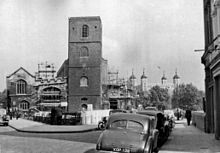All Hallows-by-the-Tower
All Hallows-by-the-Tower is an Anglican church in the City of London . It is located on Byward Street next to the Tower of London on Tower Hill . The church dates back to the 7th century and the parts that have survived from this period are the oldest surviving parts of a church in all of London. The arch in the interior is an outstanding testimony to Anglo-Saxon architecture in the city.
history
The church was founded in 675 by Barking Abbey . It was originally called All Hallows Berkyngechirche by the Tower , which over time was shortened to All Hallows Barking by the Tower , the Barking deleted the parish in the first half of the 20th century.
In 1650, an explosion of gunpowder stored in the churchyard caused a fire and the tower burned down. A new one was built in 1659, one of the few church buildings built during the English Civil War. From this tower, in turn, Samuel Pepys watched the Great Fire of London in 1666 . During the Second World War, the church was badly damaged by German air raids in 1940. The reconstruction and re-consecration lasted until 1957. During the construction work, the construction workers discovered an arch from the 7th century, making it one of the oldest parts of the building in London.
architecture
The church essentially consists of four parts: the main building, the outer walls of which date predominantly from the 14th and 15th centuries, the interior, the shape of which essentially goes back to the reconstruction of 1957 based on plans by Baron Mottistone and his architectural office Seely & Paget , the tower from the 17th century and the small underground crypt with parts from the 2nd to the 7th century.
The interior burned in 1940 and was redesigned in a post-war neo-Gothic variant. However, pieces from other churches were brought to All Hallows for renovation. The 15th century altar comes from Flanders. Statues of Saint James and Saint Roch are also from this period . The pulpit dates from the 17th century by Grinling Gibbons and was previously in the Church of St. Swithun London Stone . The baptismal font is also a Grinling Gibbons work.
In the interior of the church there is an Anglo-Saxon sandstone arch from the 7th or early 8th century, which is decorated with tiles of Roman origin. On the bottom there are some old engraved metal plates ( brass ); the church housed one of London's brass rubbing centers. The numerous votive naves inside the church are mostly more recent .
The churchyard was closed to burials in 1850 and has been used as a public green space since 1875. There has been a restaurant next to the garden since 1990, run jointly by the Diocese of London and a number of non-profit organizations. The churchyard has been reduced in size several times over the centuries. Tower Hill Terrace to the east and Tower Place to the south were built on the site of the former churchyard. The remaining remains are east of the church and are overgrown with grass. There are still some gravestones and mausoleums on the site.
organ
The first organ was built between 1519 and 1520 by the organ builder Anthony Duddyngton. In the middle of the 17th century this instrument was replaced by a new one, which was expanded and rebuilt several times over the years. In 1940 it was destroyed in a bombing raid. The current instrument was built in 1957 by the organ builders Harrison & Harrison (London). In 1991 the organ was revised by the organ builders Bishop & Son. The instrument has 44 registers on three manuals and a pedal . The playing and stop actions are electro-pneumatic.
|
|
|
|
|||||||||||||||||||||||||||||||||||||||||||||||||||||||||||||||||||||||||||||||||||||||||||||||||||||
local community
The community has always had close ties to seafaring. We are currently in close contact with the Toc H movement, to which a chapel in the church is dedicated. After Toc H was founded during World War I, founder Tubby Clayton was vicar in All Hallows from 1922 to 1963 and expanded it into Toc H's central church. Clayton's ashes are in an urn behind the altar cross. Since the entire City of London only has 9,000 residents today, but 300,000 people work in the city, today almost exclusively commuters and tourists come to church. There are close ties to the surrounding companies.
In the church was, among other things William Penn who later founded Pennsylvania, baptized, as was the later Bishop Lancelot Andrewes . The future US President John Quincy Adams married in All-Hallows. According to legend, Richard the Lionheart's heart was buried in the churchyard.
Regular customs include the annual beating of the bounds , in which the boundaries of the parish are marked, and the delivery of Knolly's rose . This goes back to a judgment in 1381 - every year a rose is brought to the Lord Mayor of London on the altar cushion of the church .
Remarks
- ^ A b Ralph Merrifield: London, city of the Romans University of California Press, 1983 ISBN 0-520-04922-5 p. 267
- ↑ a b c d Paul Middleton: All Hallows-by-the-Tower in: Leigh Hatts: London City Churches Bankside Press, 2003 ISBN 0954570502 p. 10
- ↑ a b c Beata Moore: The Square Mile: A Photographic Portrait of the City frances lincoln ltd, 2010 ISBN 0711230277 p. 105
- ^ A b London Gardens Online: All Hallows-by-the-Tower Churchyard
- ↑ information on organ (English)
- ^ John Wittich: Churches, Cathedrals and Chapels Gracewing Publishing 1988 ISBN 0-852-44141-X p. 40
Web links
Coordinates: 51 ° 30 ′ 33.7 " N , 0 ° 4 ′ 45.5" W.





